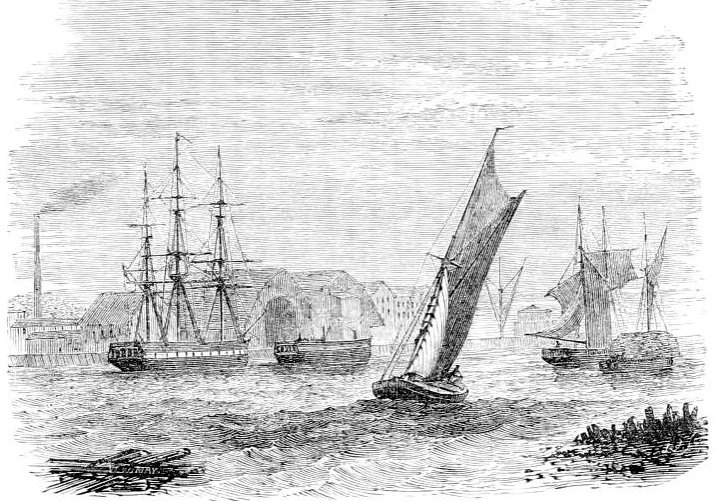
Woolwich Dockyard. 1859. Engraving of a drawing by Walter W. May, R.N. From The Book of the Thames from its Rise to its Fall, p. 492. Text and formatting by George P. Landow. [You may use this image without prior permission for any scholarly or educational purpose as long as you (1) credit the University of Pittsburgh and the Internet Archive and (2) link your document to this URL in a web document or cite the Victorian Web in a print one.]
The Halls on Woolwich Dockyard
Woolwich . . . the noblest dockyard of the world, — its foundry, its arsenal, its schools, and its barracks. It is the most ancient of those magazines of our national strength and glory, and has furnished our country with most of its largest ships during the course of several reigns, — from that of Henry VIII., when the big Harry Grace de Dieu was launched here, to that of Queen Victoria, when it may be said to have achieved its highest glory. . . . .
From North Woolwich the Dockyard may best be seen, with its long sea or river wall, extending from Charlton to the lower part of the town; and this surface being covered with sheds, factories, and basins (containing many of our war-steamers, with several ships building of the first class), it assumes a singularly interesting appearance. The river here is also dotted with picturesque hulks, reminding one of olden times and fights long past; they loom large against the departing sun-light, with the dockyard shears rearing up, endeavouring to compete with the great factory funnel for height. In the distance may he seen many of the numerous shipping dropping up the river witli the last of the flood-tide. [492]
Related Material
References
Hall, Samuel Carter, and A. M. Hall. The Book of the Thames from its Rise to its Fall. London: Arthur Hall, Virtue, and Cp., 1959. Internet Archive version of a copy in the William and Mary Darlington Memorial Libray, the University of Pittsburgh. Web. 10 March 2012.
Last modified 10 March 2012